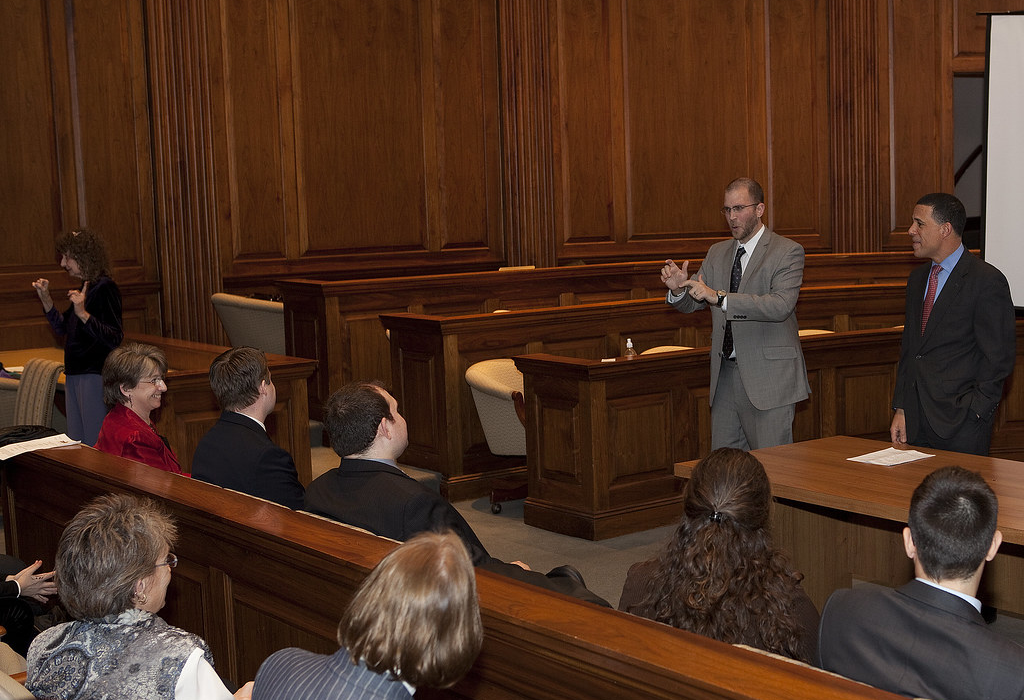
In recent years, there has been significant discourse about equality for deaf and hard-of-hearing (DHH) individuals, but the insight of Norwegian Legislators means that spaces for DHH folks emphasize equity as opposed to equality. While Norway’s Education Act 1998 highlighted one education system for all, the goal was adjusted education, as opposed to lumping hearing, deaf, and late-deafened students altogether.
The Education Act 1998 has made a major impact on DHH education. A training program was introduced for hearing parents with DHH children to learn Norwegian Sign Language (NSL). The parents are entitled to take 40 weeks of training for the first sixteen years of the child’s life. The law gives all Norwegians the right to education accessible in their neighborhood. (Skarbrevik, 2001), Sections 2-6 of the Act do not discriminate between levels of hearing impairment so that the legal right extends to all DHH students.
Accessibility within the work sector for the DHH community.
Another area of progress is in the workplace. The Norwegian government enacted the Anti-Discrimination and Accessibility Act 2008 which requires private employers and public authorities who have more than 50 employees to make systematic efforts to prevent discrimination based on “disability.” The 2008 Act does not specify DHH employees but it has clauses for individual accommodation that need to be provided for all differently-abled employees. Another integral law is the Working Environment Act enforced in 2006 which states that special accommodation needs to be provided for employees with a “reduced capacity” for work. This also extends to employees who develop a need for facilitation which includes late-deafened employees.
To safeguard against employers who do not follow these rules, employers are required to account for the work on non-discrimination in their annual report which is a publicly available document. This legislation has helped foster a more inclusive work environment and increased employment rates among the DHH community.
Norwegian efforts in the arts are also admirable. In 1999, Norway’s first-ever NSL theater was established. Teater Manu was created for the purpose of educating DHH actors at a high professional level. The theatre has also provided DHH performers to tour the country.
The Norwegian Legal System for DHH people.
As a general rule, the courts are required to follow precedents and apply legal principles that have been well-established. The benefit this serves is that parties coming to court know what to expect. Legal recourse needs to be clear when it comes to DHH individuals because litigation involves a great deal of oral communication. If you are a victim of a crime you will need to recount the event, provide your testimony to the court, and communicate your needs to your counsel. The existence of an interpreter also creates ambiguity because incorrect interpretation can impede the outcome of the case.
How has the Norwegian government catered to DHH victims, suspects, or witnesses? This is particularly important considering that differently-abled people have a higher risk for violence, sexual abuse, or harassment, whether they be adults or minors. (Kvam 2000, 2001, 2004) The Criminal Procedure Act clearly states that a deaf person is entitled to have an interpreter. The challenge is to use a minimum of two cooperating interpreters to mediate the communication between the two interactive parties.
In a research article by Terje Olsen & Patrick Kermit (2015) titled Sign Language, translation and Rule of Law – deaf people’s Experiences from Encounters with the Norwegian Criminal Justice System, it was suggested that DHH suspects often face discrimination. The writers discuss that “David” was taken to a police station after a fight in a taxi queue. Rather than providing him with an interpreter, the police told him to stop playing deaf and demanded that he communicate with them. Additionally, “David” was charged with contempt against police officers because of his non-compliance. Eventually, the charges were dropped but “David” never received an apology. Another instance of discrimination is with “George” who was told to attend his interrogation through a phone call. “George,” thought that he received calls incorrectly, and after three calls he told them that he was deaf and could not understand what was being said. This is when “George” received a text message stating he was facing charges of domestic violence and needed to come in for interrogation. The point to note is that not everyone is fluent in sign language and despite the legal requirement, not everyone is provided with an interpreter. Additionally, NSL is not rich in vocabulary when it comes to criminal justice. The article also shared the story of a suspect who was interrogated twice without interpreters.
Interactions with the police are overwhelming and stressful for everyone, but differently-abled and DHH people are more susceptible to losing control of their narrative. The research article highlights that DHH individuals feel as though they have very little idea about the context in which their statement is being recorded. A DHH person’s statement may have been intended one way, and interpreted in a completely different way by the police. The article also states that DHH informants have shared their despondence upon discovering the results of the court cases.
This shows that there is room for growth when it comes to the legal sector. Interpreters need to be provided to all DHH victims and suspects and work needs to be done to elaborate NSL to include complex terms that the criminal justice system covers.
Unfortunately, the issues faced by DHH suspects and victims are not limited to Norway. The accessibility issues extend to many countries, most of which have not made the extent of efforts made by the Norwegian government.
Unspoken Languages Services is an American Sign Language Interpretation service provider that aims to bridge the gap in communication and create an accessible environment for all.
Thumbnail Photo Credit to: “Deaf and Hard of Hearing Awareness Day Awards” by MDGovpics is licensed under CC BY 2.0.

